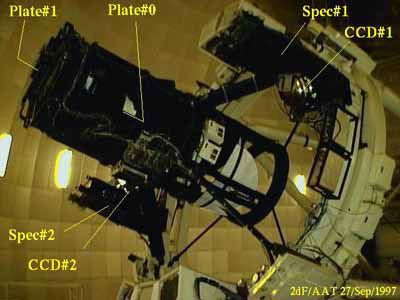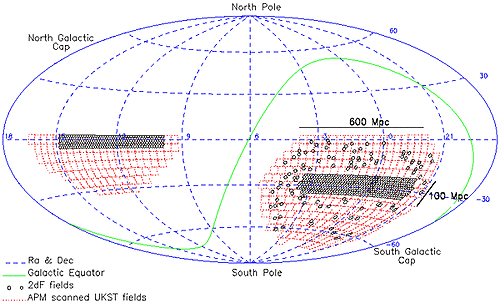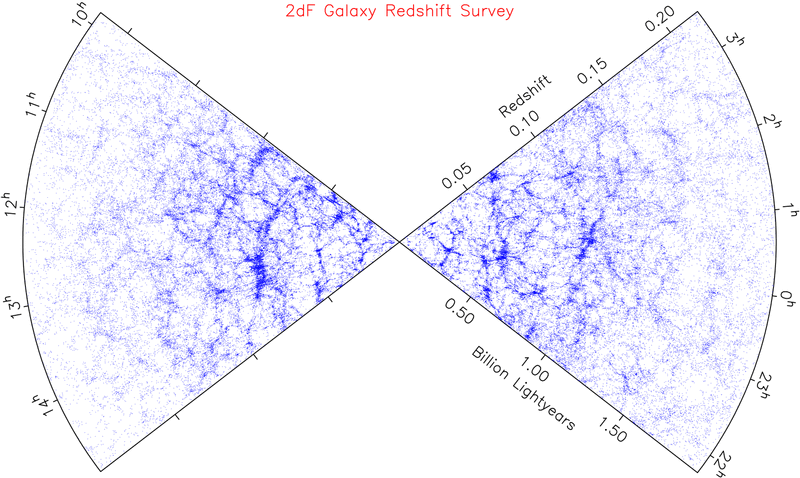 The 2df on the AAT [<] 1 of 12 [>] |
|
The Two Degree Field system (2dF) is fitted to the Anglo-Australian Telescope. It is the AAO's (and, in 1997 when it began operations, was arguably the world's) most complex astronomical instrument. It acquires up to 400 simultaneous spectra of objects anywhere within a two degree field on the sky. It consists of a wide field corrector, an atmospheric dispersion compensator, a robot gantry which positions optical fibres to 0.3 arc seconds and two spectrographs each of which accepts 200 of the fibres to produce low to medium resolution spectra. A tumbling mechanism with two field plates allows a second field to be configured while the first is acquiring spectra. |
2dFGRS - An Introduction
Source: This page was assembled in May 2005 from material at: http://magnum.anu.edu.au/~TDFgg/. The home page of the survey is now at: www2.aao.gov.au/2dFGRS/. There is also an article at: Wikipedia - 2df Galaxy Redshift Survey. The 2df System side box, right, was added in August 2007.
The 2dF Galaxy Redshift Survey (2dFGRS) was a major spectroscopic survey that utilised the unique capabilities of the 2dF facility at the Anglo-Australian Observatory - see box on right.
The 2dFGRS obtained spectra for 245,591 objects, mainly galaxies, brighter than magnitude 19.45. Reliable redshifts were obtained for 221,414 galaxies. The galaxies cover an area of approximately 1,500 square degrees in three regions: a North Galactic Pole strip, a South Galactic Pole strip and random fields scattered around the SGP strip. The arrangement of survey fields is shown here:
Map of the survey fields
Click to enlarge
The 2dFGRS survey and its database are described in detail in Colless et al. (2001)
The final release database can be accessed from the 2dFGRS Home Page.
Here is a map of the galaxy distribution produced from the completed survey. (Other versions of this figure in various image formats are accessible from the 2dFGRS gallery). Click the map for a higher resolution view.
The survey has been used to address a variety of fundamental problems in galaxy formation and cosmology. Survey results include:
- An accurate measurement of the power spectrum of galaxy clustering on scales up to 300h-1 Mpc, allowing precise determinations of the total mass density of the universe and the baryon fraction.
- Measurements of the distortion of the clustering pattern in redshift space, providing independent constraints on the total mass density and the spatial distribution of dark matter.
- A strong new upper limit on the total neutrino mass.
- In combination with observations of the cosmic microwave background (CMB), precise measurements of the Hubble constant and the baryon density, evidence for a non-zero cosmological constant (dark energy), and constraints on the equation of state of the dark energy.
- The first direct measurements of the galaxy bias parameter, both from higher-order correlations in the galaxy distribution and from comparison with the CMB power spectrum.
- A characterization of the galaxy luminosity function in both the optical and near-infrared with the former yielding the mean current star-formation rate and the latter the stellar mass function of galaxies.
- The distribution of galaxies as a joint function of total luminosity and central surface brightness.
- The luminosity functions for galaxies with different spectral types, both in the field and in clusters.
- The variation in clustering properties of galaxies as functions of luminosity and spectral type.
- Constraints on the cosmic star-formation history from the mean galaxy spectrum in the local universe and the environmental dependence of star-formation rates of galaxies around clusters.
- The properties and luminosity functions of radio sources of various types..
- The properties of previously-identified clusters of galaxies in the survey, and dynamical estimates of the cluster masses.
The final release dataset comprises the following elements:
- The input (source catalogues) for the full 2dFGRS survey, containing data for 382,323 objects, together with related material.
- The spectroscopic catalogues for 245,591 objects, containing the spectroscopic parameters such as redshifts and spectral types.
- The mSQL database, which allows searching and subsetting of the public release data, and provides access to the FITS files containing the spectra as well as all the other photometric and spectroscopic parameters.
- The survey mask software for determining whether a given position is in the survey region, and the survey magnitude limit and redshift completeness at that position; also selection software for extracting various types of subsamples and creating corresponding mock catalogues.
- Documentation, both on-line and through links to survey publications.
- Additional material such as images, movies, stills, media reports and links to related topics.

